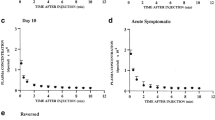Summary
The blood–brain barrier (BBB) metabolically isolates the central nervous system (CNS) from the circulation and protects it against fluctuations of hydrophilic nutrients in plasma and from intoxication. Recent studies have shown that dicarboxylic acids (DCAs) are transported across the blood–brain barrier at very low rates. In organic acidaemias, neurological complications are common. We hypothesize that, as a result of the very limited efflux, in certain organic acidaemias there is pathological accumulation of DCAs (e.g. glutarate, 3-hydroxyglutarate, D-2- and L-2-hydroxyglutarate, methylmalonate) in the brain secondary to the metabolic block. At high concentrations some of these compounds may become neurotoxic. Treatment should be aimed at preventing the accumulation of these compounds using our understanding of the properties of the BBB.
Similar content being viewed by others
Abbreviations
- BBB:
-
blood–brain barrier
- CNS:
-
central nervous system
- CSF:
-
cerebrospinal fluid
- DCA:
-
dicarboxylic acid
- OADs:
-
organic acid disorders
References
Baric I, Wagner L, Feyh P, Liesert M, Buckel W, Hoffmann GF (1999) Sensitivity and specificity of free and total glutaric and 3-hydroxyglutaric acids measurements by stable isotope dilution assays for the diagnosis of glutaric aciduria type I. J Inherit Metab Dis 22: 867–881.
Barth P, Hoffmann GF, Jaeken J, et al (1992) L-2-Hydroxyglutaric acidemia: a novel inherited neurometabolic disease. Ann Neurol 32: 66–71.
Brusilow SW (2001) Urea cycle enzymes. In: Scriver CR, Beaudet AL, Sly WS, Valle D, eds; Childs B, Kinzler KW, Vogelstein B, assoc. eds. The Metabolic and Molecular Bases of Inherited Disease, 8th edn. New York: McGraw-Hill, 1909–1963.
Busquets C, Merinero B, Christensen E, et al (2000) Glutaryl-CoA dehydrogenase deficiency in Spain: evidence of two groups of patients, genetically and biochemically distinct. Pediatr Res 48: 315–322.
Funk CB, Prasad AN, Frosk P, et al (2005) Neuropathological, biochemical, and molecular findings in a glutaric acidemia type 1 cohort. Brain 128: 711–722.
Gerrits GP, Gabreels FJ, Monnens LA, et al (1993) Argininosuccinic aciduria: clinical and biochemical findings in three children with the late onset form, with special emphasis on cerebrospinal fluid findings of amino acids and pyrimidines. Neuropediatrics 24: 15–18.
Goodman SI, Norenberg MD, Shikes RH, Breslich DJ, Moe PG (1977) Glutaric aciduria: biochemical and morphological considerations. J Pediatr 90: 746–750.
Hassel B, Brathe A, Petersen DJ (2002) Cerebral dicarboxylate transport and metabolism studied with isotopically labelled fumarate, malate and malonate. J Neurochem 82: 410–419.
Hoffmann GF, Meier-Augenstein W, Stöckler S, Surtees R, Rating D, Nyhan WL (1993) Physiology and pathophysiology of organic acids in cerebrospinal fluid. J Inherit Metab Dis 16: 648–669.
Hoffmann GF, Gibson KM, Trefz FK, Nyhan WL, Bremer HJ, Rating D (1994) Neurological manifestations of organic acid disorders. Eur J Pediatr 153(Supplement 1): S94–S100.
Hoffmann GF, Athanassopoulos S, Burlina AB, et al (1996) Clinical course, early diagnosis, treatment, and prevention of disease in glutaryl-CoA dehydrogenase deficiency. Neuropediatrics 27: 115–123.
Hümer M, Muehl A, Wandl-Vergesslich K, Strobl W, Wanders RJ, Stoeckler-Ipsiroglu S (1998) Stroke-like encephalopathy in an infant with 3-hydroxy-3-methylglutaryl-coenzyme A lyase deficiency. Eur J Pediatr 157: 743–746.
Kölker S, Pawlak V, Ahlemeyer B, et al (2002) NMDA receptor activation and respiratory chain complex V inhibition contribute to neurodegeneration in D-2-hydroxyglutaric aciduria. Eur J Neurosci 16: 21–28.
Kölker S, Koeller DM, Okun JG, Hoffmann GF (2004) Pathomechanisms of neurodegeneration in glutaryl-CoA dehydrogenase deficiency. Ann Neurol 55: 7–12.
Kölker S, Garbade SF, Greenberg CR, et al (2006) Natural history, outcome, and treatment efficacy in children and adults with glutaryl-CoA dehydrogenase deficiency. Pediatr Res 59: 840–847.
Külkens S, Harting I, Sauer S, et al (2005) Late-onset neurologic disease in glutaryl-CoA dehydrogenase deficiency. Neurology 64: 2142–2144.
McLaughlin BA, Nelson D, Silver IA, Erecinska M, Chesselet MF (1998) Methylmalonate toxicity in primary neuronal cultures. Neuroscience 86: 279–290.
Mühlhausen C, Ott N, Chalajour F, et al (2006) Endothelial effects of 3-hydroxyglutaric acid: implications for glutaric aciduria type I. Pediatr Res 59: 196–202.
Nicolaides P, Leonard JV, Surtees R (1998) Neurological outcome of methylmalonic acidaemia. Arch Dis Child 78: 508–512.
Pietz J, Kreis R, Rupp A, et al (1999) Large neutral amino acids block phenylalanine transport into the brain in patients with phenylketonuria. J Clin Invest 103: 1169–1178.
Saudubray JM, Touati G, de Lonlay P, et al (1999) Liver transplantation in urea cycle disorders. Eur J Pediatr 158(Supplement 2): S55–S59.
Sauer SW, Okun JG, Schwab MA, et al (2005) Bioenergetics in glutaryl-coenzyme A dehydrogenase deficiency, a role for glutaryl-coenzyme A. J Biol Chem 280: 21830–21836.
Sauer SW, Okun JG, Fricker G, et al (2006) Intracerebral accumulation of glutaric and 3-hydroxyglutaric acids secondary to limited flux across the blood—brain barrier constitute a biochemical risk factor for neurodegeneration in glutaryl CoA dehydrogenase deficiency. J Neurochem 97: 899–910.
Stone TW (2001) Kynurenines in the CNS: from endogenous obscurity to therapeutic importance. Prog Neurobiol 64: 185–218.
Stone TW, Perkins MN (1981) Quinolinic acid: a potent endogenous excitant at amino acid receptors in CNS. Eur J Pharm 72: 411–412.
Strauss KA, Puffenberger EG, Robinson DL, Morton DH (2003) Type I glutaric aciduria, part 1: natural history of 77 patients. Am J Med Genet C Semin Med Genet 121: 38–52.
Tamai I, Tsuji A (2000) Transporter-mediated permeation of drugs across the blood—brain barrier. J Pharm Sci 89: 1371–1388.
Varadkar S, Surtees R (2004) Glutaric aciduria type 1 and kynurenine pathway metabolites: a modified hypothesis. J Inherit Metab Dis 27: 835–842.
Yodoya E, Wada M, Shimada A, et al (2006) Functional and molecular identification of sodium-coupled dicarboxylate transporters in rat primary cultured cerebrocortical astrocytes and neurons. J Neurochem 97: 162–173.
Zinnanti WH, Lazovic J, Wolpert EB, et al (2006) A diet-induced mouse model for glutaric aciduria type I. Brain 129: 899–910.
Author information
Authors and Affiliations
Corresponding author
Additional information
Communicating editor: Johannes Zschocke
Competing interests: None declared
Rights and permissions
About this article
Cite this article
Kölker, S., Sauer, S.W., Surtees, R.A.H. et al. The aetiology of neurological complications of organic acidaemias—A role for the blood–brain barrier. J Inherit Metab Dis 29, 701–704 (2006). https://doi.org/10.1007/s10545-006-0415-8
Received:
Revised:
Accepted:
Published:
Issue Date:
DOI: https://doi.org/10.1007/s10545-006-0415-8




